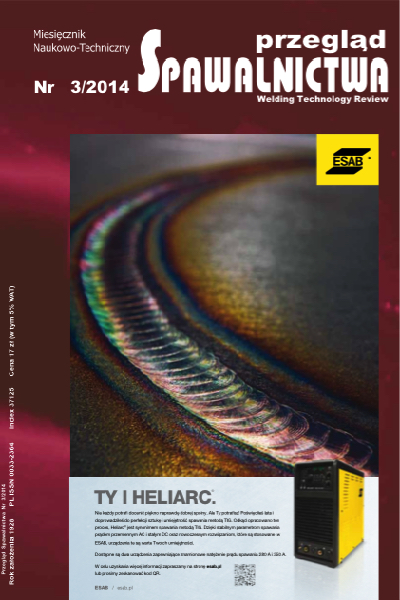Termografia aktywna jako nowa metoda badań nieniszczących połączeń zakładkowych spawanych laserowo
Main Article Content
Abstract
W artykule przedstawiono zastosowanie termografii aktywnej do badań nieniszczących połączeń zakładkowych blach spawanych laserowo bez pełnego przetopienia. Opisano opracowaną metodologię badań, sposób wytworzenia połączeń próbnych oraz zastosowane stanowisko badawcze. Uzyskane obrazy termograficzne zostały poddane analizie polegającej na wyznaczeniu maksymalnego kontrastu temperaturowego. Ocenę wykonanych połączeń przeprowadzono na podstawie analizy makrostruktury wybranych przekrojów poprzecznych próbek. Na podstawie wyników badań termograficznych stwierdzono, że zaproponowana metoda może być z powodzeniem zastosowana do nieniszczących badań połączeń zakładkowych spawanych laserowo.
Active thermography as a new non-destructive testing method of laser welded lap joints
Absô°¤ô°tract
The application of active thermography for non-destructive testing of laser welded lap joints (with partial joint penetration) was presented in this article. The methodology, specimen preparation and applied apparatus were described. Thermal images of the specimens obtained during experiments were analyzed using procedure based on maximum thermal contrast determination. Prepared la- ser welded lap joints were examined using typical macro image analysis of selected cross sections of joints. The obtained experimental results showed that considered method has a great potential to be successfully applied for non-destructive testing of laser welded lap joints.
Downloads
Article Details
Creative Commons CC BY 4.0 https://creativecommons.org/licenses/by/4.0/
Welding Technology Review (WTR) articles are published open access under a CC BY licence (Creative Commons Attribution 4.0 International licence). The CC BY licence is the most open licence available and considered the industry 'gold standard' for open access; it is also preferred by many funders. This licence allows readers to copy and redistribute the material in any medium or format, and to alter, transform, or build upon the material, including for commercial use, providing the original author is credited.
References
Ma J., Kong F., Carlson B., Kovacevic R.: Mitigating zinc vapor induced weld defects in laser welding of galvanized high-strength steel by using different supplementary means. Welding Processes. Intech, New York, 2012, 117÷138.
Cavusoglu N., Ozden H.: Automobile manufacturing using laser beam welding. Welding Journal, vol. 92, no. 2, 2013, 32÷37.
Stano S.: New solid-state lasers and their application in welding as generators of laser radiation, Welding International, 21/3, 2007, 173÷179.
Grajcar A., Różański M., Stano S., Kowalski A., Grzegorczyk B.: Effect of heat input on microstructure and hardness distribution of laser welded Si-Al TRIP-type steel, Advances in Materials Science and Engineering, vol. 2014, ID 658947, 1÷8.
UltraLight Steel Auto Body Final Report, First edition. American Iron and Steel Institute, Washington, USA, 1998.
Mei L., Yi J., Yan D., Liu J., Chen G.: Comparative study on CO2 laser overlap welding and resitance spot welding for galvanized steel. Materials and Design 40, 2012, 433÷442.
Chen G., Mei L., Zhang M., Zhang Y., Wang Z.: Research on key influence factors of laser overlap welding of automobile body galvanized steel. Optics & Laser Technology, vol. 45, 2013, 726÷733.
Kong F., Ma J., Carlson B., Kovacevic R.: Real-time monitoring of laser welding of galvanized high strength steel in lap joint configuration. Optics & Laser Technology 44, 2012, 2186÷2196.
Gruszczyk A., Sędek B.: Odporność korozyjna połączeń lutospawanych stali ocynkowanej. Przegląd Spawalnictwa nr 9/2007, 32÷36.
Bates D., Smith G., Lu D., Hewitt J.: Rapid thermal non-destructive testing of aircraft components. Composites: Part B 31, 2000, 175÷185.
Pawlak S., Różański M., Muzia G.: Zastosowanie termografii aktywnej do badań nieniszczących połączeń lutowanych. Przegląd Spawalnictwa nr 2/2013, 24÷28.
Pawlak S.: Termograficzna metoda oceny rozkładu udziału włókien w kompozytach epoksydowo-węglowych (rozprawa doktorska). Politechnika Śląska w Gliwicach, Wydział Mechaniczny Technologiczny, Gliwice 2010.
